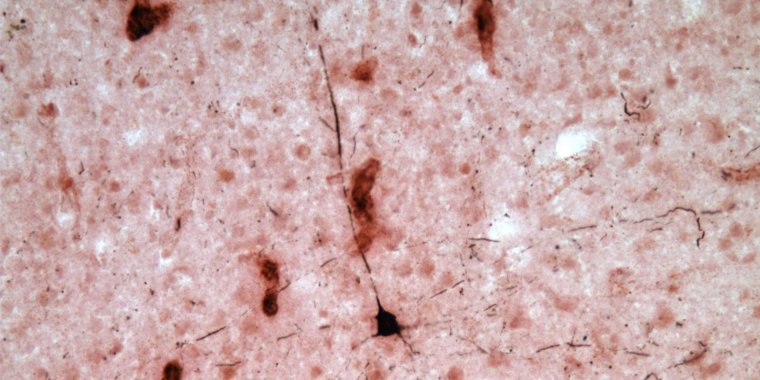| Health / Health News |
New research detects Alzheimer's disease markers in nonhuman primates
As a part of their research to understand the evolution of the human brain and how it differs from those of other primates, scientists from Kent State University discovered proteins associated with Alzheimer's disease -- believed to be unique to humans -- in a sample of brains of aged chimpanzees.

Tau black tangles and amyloid beta in the brain of a 57-year-old chimpanzee. The tau-positive neuron in the center (black) is at the pretangle/tangle stage. The amyloid beta deposits are present in nearby blood vessels (red). ![]()
Alzheimer's is a clinical disorder partially confirmed at autopsy by the co-occurrence in the brain of two proteins: amyloid beta, and a second called tau.
The scientists say that the detection of both amyloid beta and tau in aged chimps suggests that Alzheimer's-like pathology is not limited to the human brain.
It has been suggested that humans are uniquely susceptible to Alzheimer's, potentially because of genetic differences from other primates, changes to the human brain during evolution, and longer lifespans.
Age-related comparisons of the brains of humans and chimpanzees, the closest living relatives to humans, are challenging because of the scarcity of samples from older chimpanzees. In captivity, only 10 percent of male chimpanzees live to age 45 and only 10 percent of females to 55.
The research team examined brain specimens from a group of 20 aged chimpanzees.
The researchers found significant evidence of amyloid beta and tau lesions in the same brain regions affected by Alzheimer's in humans.
While there have been age-related studies of great apes, the profound memory impairment found in Alzheimer's patients has not yet been demonstrated in nonhuman primates.
Along with autopsy results, a diagnosis of Alzheimer's requires data from behavioral and cognitive testing to determine whether amyloid beta and tau lesions are associated with cognitive decline. At present, there are no studies that consider both cognitive data and autopsy results from the same apes to distinguish between normal and pathologic aging processes.
But the identification in the aged chimpanzees of amyloid beta and tau lesions, hallmarks of Alzheimer's diagnosis, is a significant advance in understanding the brain and Alzheimer's. (National Science Foundation)
YOU MAY ALSO LIKE



